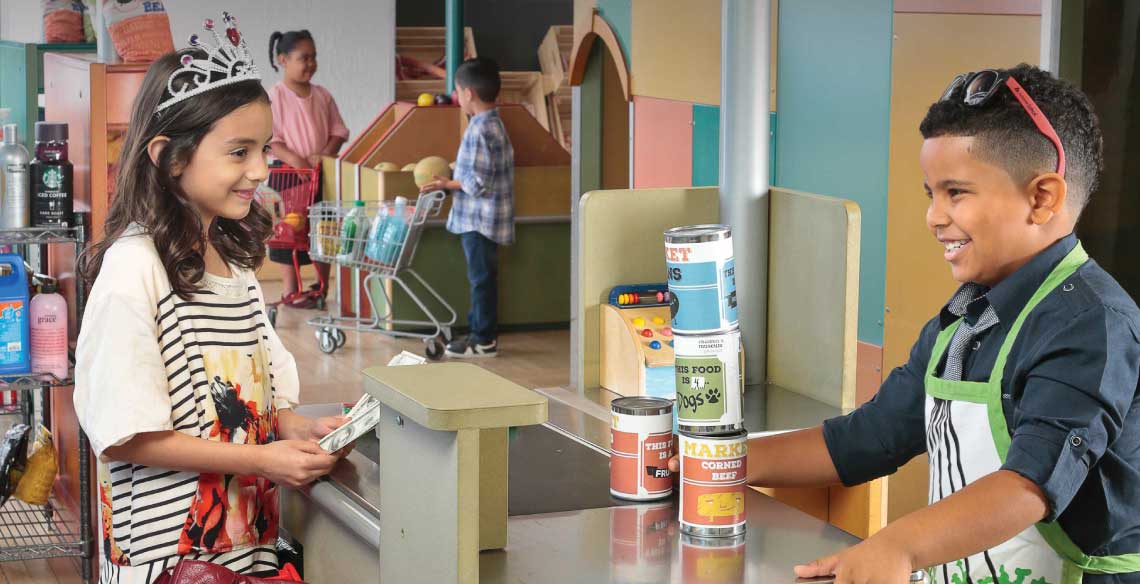As parents, we strive to teach our kids things like good manners, social skills, how to cook – life skills that will help them grow into independent, young adults. But, according to a 2017 T. Rowe Price survey, when it comes to talking to our kids about money, 69% of parents have some reluctance.
Start Early
Handling money is a skill that must be taught. Although kids usually don’t learn how to count money until kindergarten or the first grade, a study by researchers at the University of Cambridge found most children’s habits and attitudes about money are formed by age 7.
Start by teaching younger children things like where money comes from and ways it is earned (jobs, chores, etc.). Even in the digital age, old-school games and activities – like playing store or sorting coins and saving them in a piggy bank (or clear plastic jar) – are still great ways to help kids learn how to count coins and start saving.
Wants & Needs
One key lesson that will help your kids learn to make smarter choices when it comes to spending and saving is understanding the difference between wants and needs.
For example, you can talk to them about how we “need” food and water, and even though we may really “want” to buy a piece of candy, it isn’t a necessity.
Teachable Moments
Take the opportunity to use everyday situations as teaching moments. A trip to the store is a great time for lessons on how to comparison shop for sale items, how to use coupons and the difference between name-brands versus store-brands. When you’re in the checkout line, you can point out the different ways to pay (cash, check and debit/credit card).
Allowances
Unless your kid is a YouTube® celebrity – chances are they rely on you for their basic needs and pocket money for everyday expenses. And, while there is some debate on whether or not kids should have to do chores to earn an allowance, 81 percent of U.S. adults feel an allowance teaches children financial responsibility.
An allowance gives kids a regular source of “income” and – along with some guidelines for spending, saving and sharing – is a tool that can help them learn how to budget their money.
What age? The age to begin giving an allowance varies from family to family. Some experts recommend starting around age 6 or 7 when children are able to count money.
How much? According to a 2016 poll by the American Institute of Certified Public Accountants (AICPA), parents give their children on average $67.80 each month in pocket money ($814 a year). When setting up an allowance for your child, the amount will depend on what fits your family budget, but a general rule of thumb is 50 cents to a dollar per week based on the age of the child (e.g., $5 or $10 per week for a 10 year old).
Chores debate. Many parents feel that kids should have to do chores to earn an allowance. Others believe an allowance should not be tied to doing household chores, as children should be expected to help around the house because they are part of the family, not because they are paid.
One way to let kids take control of how much they earn is giving them the opportunity to earn extra money (a commission) on top of their base allowance for doing “extra” chores – so the more work they do, the more they can make.
Spend, Save, Give!
While kids should be able to spend their allowance on whatever they want (for the most part), give them guidelines on spending and saving. Many experts recommend getting your kids in the habit of using some of their allowance for savings and charity. For example, spend 70%-80%, save 10% (for bigger purchases and long-term savings), and give 10% to charity (for social responsibility).
For younger kids, try the three jar method (label a jar for “Save,” one for “Spend” and one for “Give”). For tweens (8-14 years old), you can help them open a savings account and explain how earning interest helps their money grow.
Make them pay!
As part of having an allowance, make your kids responsible for some of their expenses – like going to the movies, buying birthday gifts or saving for a new game station. This will help them learn how to handle money and work with limited funds (and live within their means).
“Show me the money”
Help your kids understand how much things cost and the value of a dollar. For younger kids, give them some change to buy candy or a snack and show them which items they can afford with their money. For teens with a part-time job, show them how many hours they would need to work to pay for their favorite sneakers or treats.
For example, a yummy Frappuccino™ costs around $5, which means if they are making minimum wage ($10) they would have to work a half an hour to pay for it. A pair of Vans® or basketball shoes can easily cost $100 (or 10 hours of labor), which for a part-timer might be their whole paycheck (especially after taxes and other deductions).
Credit Cards
Even if you don’t personally use credit cards, it’s still important to teach your kids some basics about how credit works, the different types of loans (and interest), and about credit reports and credit scores.
What age? To help teens learn how to use a credit card responsibly, some experts recommend making them an authorized user on the parent’s card around the time they start driving or have a part-time job. Others feel it’s best to make them wait until they’re 21 when they can apply for their own card and are more likely to handle it responsibly. You’ll have to decide what options works best for you and your child.
Some other options that can give your teen the experience of working with a “credit limit” include prepaid cards (watch for fees) and secured credit cards (funds are deposited into an account for collateral, then can be borrowed against and must be paid back monthly to avoid interest).
If you do give your teen a credit card, make sure they know what they are allowed to use the card for (preapproved purchases, emergencies, etc.) and the amount they will be responsible to pay when the credit card payment is due. Also, review the statement together each month.
Investing Basics
An easy way to help young teens understand some investing basics is to start by talking about stocks and how they can own a piece of their favorite stores or restaurants. Together, look up the different stock prices and follow news about the companies or even buy a share in a company.
Make sure they know investment tools carry some risks compared to other types of accounts that may be federally insured like a savings account – and, why it’s important to not put all your eggs in one basket (diversify!).
While teaching our kids about money may be uncomfortable for many of us, it’s an important topic for their success. Teach kids about matters that are age-appropriate and incorporate money conversations into everyday interactions, like grocery shopping, planning a vacation and paying bills. Before you know it, you’ll have raised a financially-savvy adult, and you may have even learned a thing or two.
Money Talks Guide for Parents and Grandparents
For a step-by-step guide to teaching your kids about money, check out Arizona Federal’s FREE Money Talks Guides for Parents or Grandparents, along with a Money Milestones Map to track their progress from preschool through young adulthood.



